ACC300 Auditing & Assurance: Identifying Control Weaknesses in Sales
VerifiedAdded on 2023/03/30
|11
|2864
|209
Report
AI Summary
This report provides a comprehensive analysis of auditing and control weaknesses within an organization, focusing on identifying material misstatements in areas such as bad debt write-offs, inventory valuation, and related party disclosures. It examines the implications of using the LIFO method versus FIFO for inventory valuation and discusses the importance of fair value assessment for assets. Furthermore, the report investigates weaknesses in sales procedures, emphasizing the need for proper bookkeeping and the use of software like Quickbooks to ensure accurate cash tracking and reduce the risk of theft or misplacement. The analysis highlights the significance of adhering to accounting standards and maintaining transparency in financial reporting to facilitate informed decision-making and prevent potential financial risks.
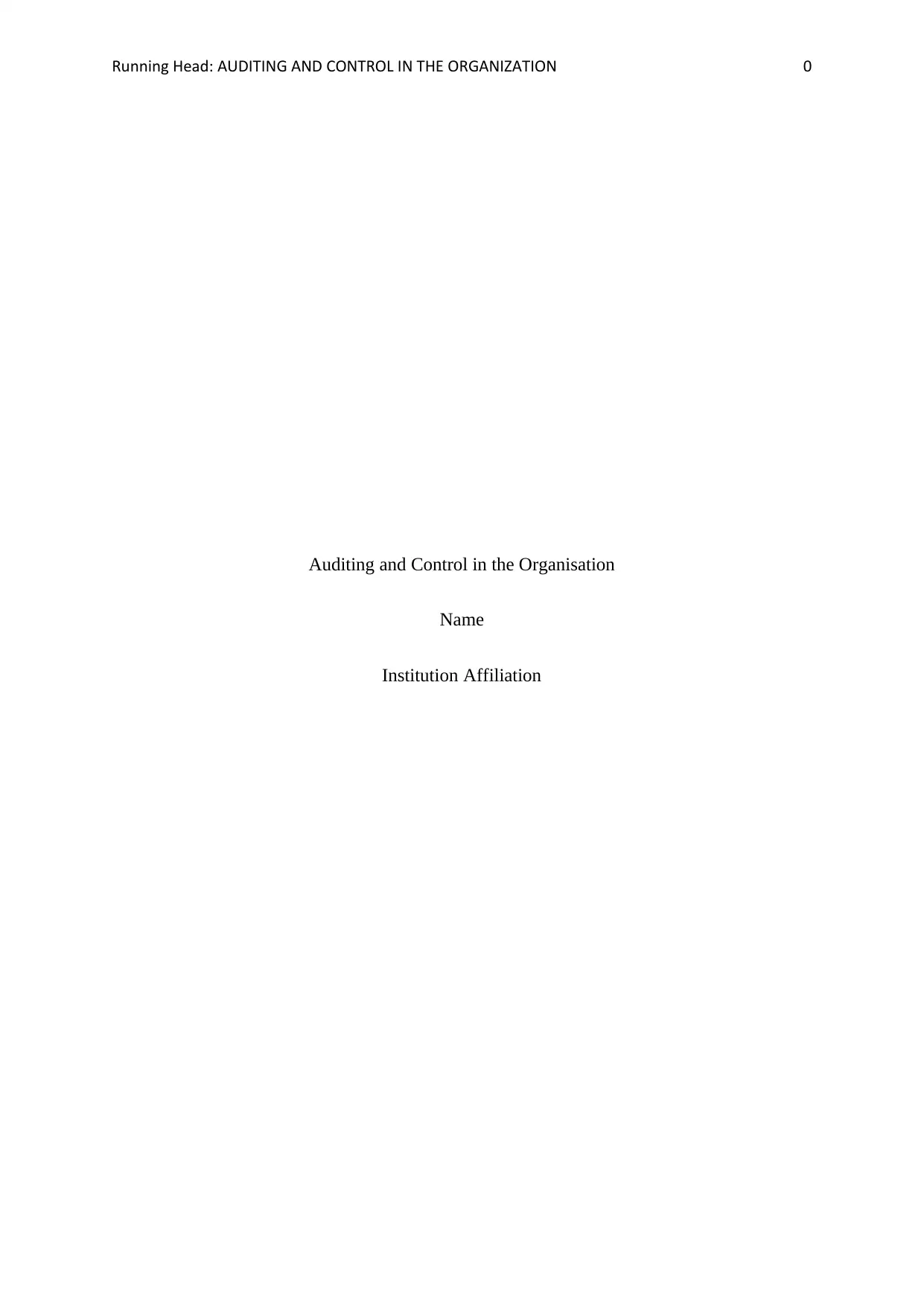
Running Head: AUDITING AND CONTROL IN THE ORGANIZATION 0
Auditing and Control in the Organisation
Name
Institution Affiliation
Auditing and Control in the Organisation
Name
Institution Affiliation
Paraphrase This Document
Need a fresh take? Get an instant paraphrase of this document with our AI Paraphraser
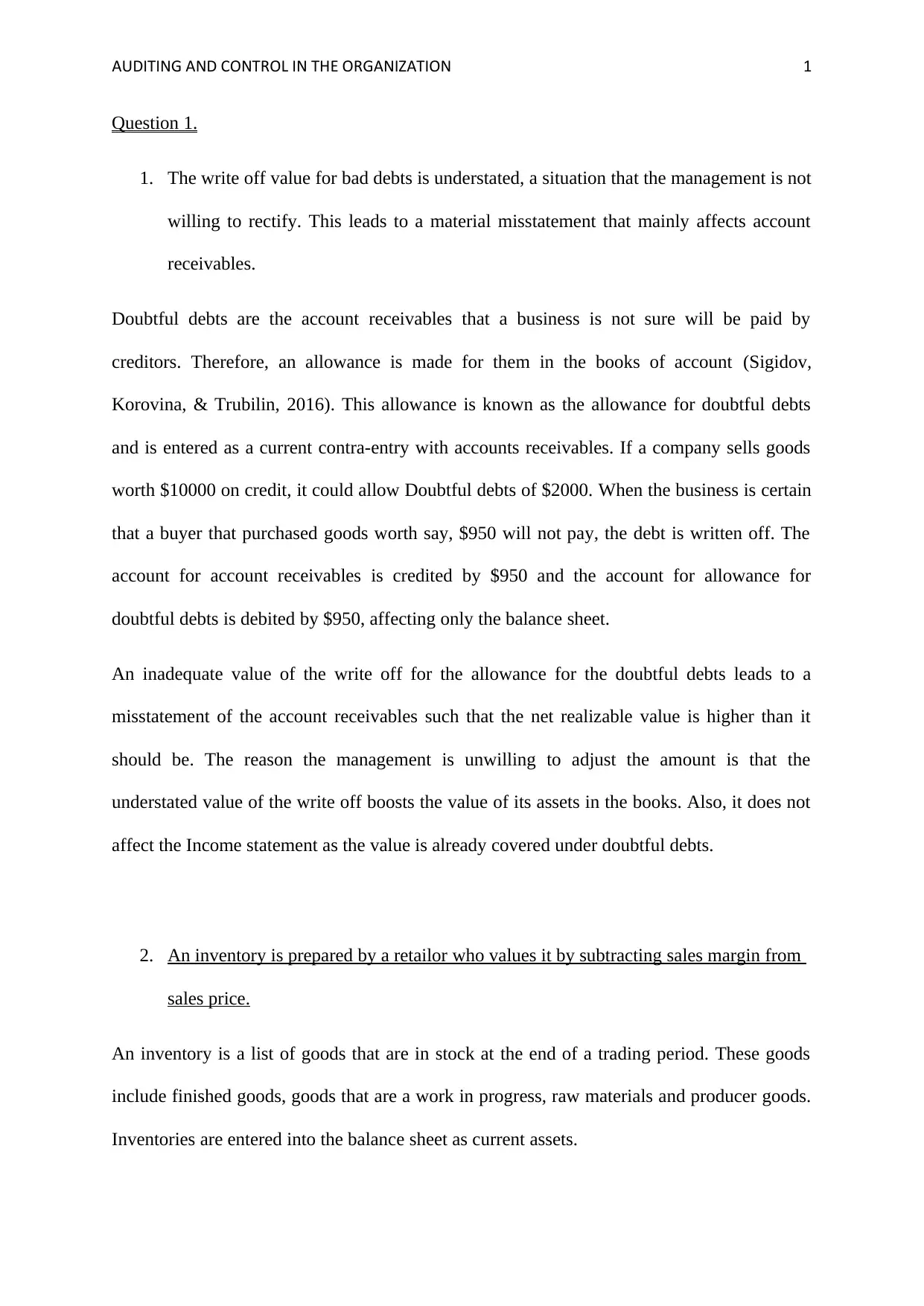
AUDITING AND CONTROL IN THE ORGANIZATION 1
Question 1.
1. The write off value for bad debts is understated, a situation that the management is not
willing to rectify. This leads to a material misstatement that mainly affects account
receivables.
Doubtful debts are the account receivables that a business is not sure will be paid by
creditors. Therefore, an allowance is made for them in the books of account (Sigidov,
Korovina, & Trubilin, 2016). This allowance is known as the allowance for doubtful debts
and is entered as a current contra-entry with accounts receivables. If a company sells goods
worth $10000 on credit, it could allow Doubtful debts of $2000. When the business is certain
that a buyer that purchased goods worth say, $950 will not pay, the debt is written off. The
account for account receivables is credited by $950 and the account for allowance for
doubtful debts is debited by $950, affecting only the balance sheet.
An inadequate value of the write off for the allowance for the doubtful debts leads to a
misstatement of the account receivables such that the net realizable value is higher than it
should be. The reason the management is unwilling to adjust the amount is that the
understated value of the write off boosts the value of its assets in the books. Also, it does not
affect the Income statement as the value is already covered under doubtful debts.
2. An inventory is prepared by a retailor who values it by subtracting sales margin from
sales price.
An inventory is a list of goods that are in stock at the end of a trading period. These goods
include finished goods, goods that are a work in progress, raw materials and producer goods.
Inventories are entered into the balance sheet as current assets.
Question 1.
1. The write off value for bad debts is understated, a situation that the management is not
willing to rectify. This leads to a material misstatement that mainly affects account
receivables.
Doubtful debts are the account receivables that a business is not sure will be paid by
creditors. Therefore, an allowance is made for them in the books of account (Sigidov,
Korovina, & Trubilin, 2016). This allowance is known as the allowance for doubtful debts
and is entered as a current contra-entry with accounts receivables. If a company sells goods
worth $10000 on credit, it could allow Doubtful debts of $2000. When the business is certain
that a buyer that purchased goods worth say, $950 will not pay, the debt is written off. The
account for account receivables is credited by $950 and the account for allowance for
doubtful debts is debited by $950, affecting only the balance sheet.
An inadequate value of the write off for the allowance for the doubtful debts leads to a
misstatement of the account receivables such that the net realizable value is higher than it
should be. The reason the management is unwilling to adjust the amount is that the
understated value of the write off boosts the value of its assets in the books. Also, it does not
affect the Income statement as the value is already covered under doubtful debts.
2. An inventory is prepared by a retailor who values it by subtracting sales margin from
sales price.
An inventory is a list of goods that are in stock at the end of a trading period. These goods
include finished goods, goods that are a work in progress, raw materials and producer goods.
Inventories are entered into the balance sheet as current assets.
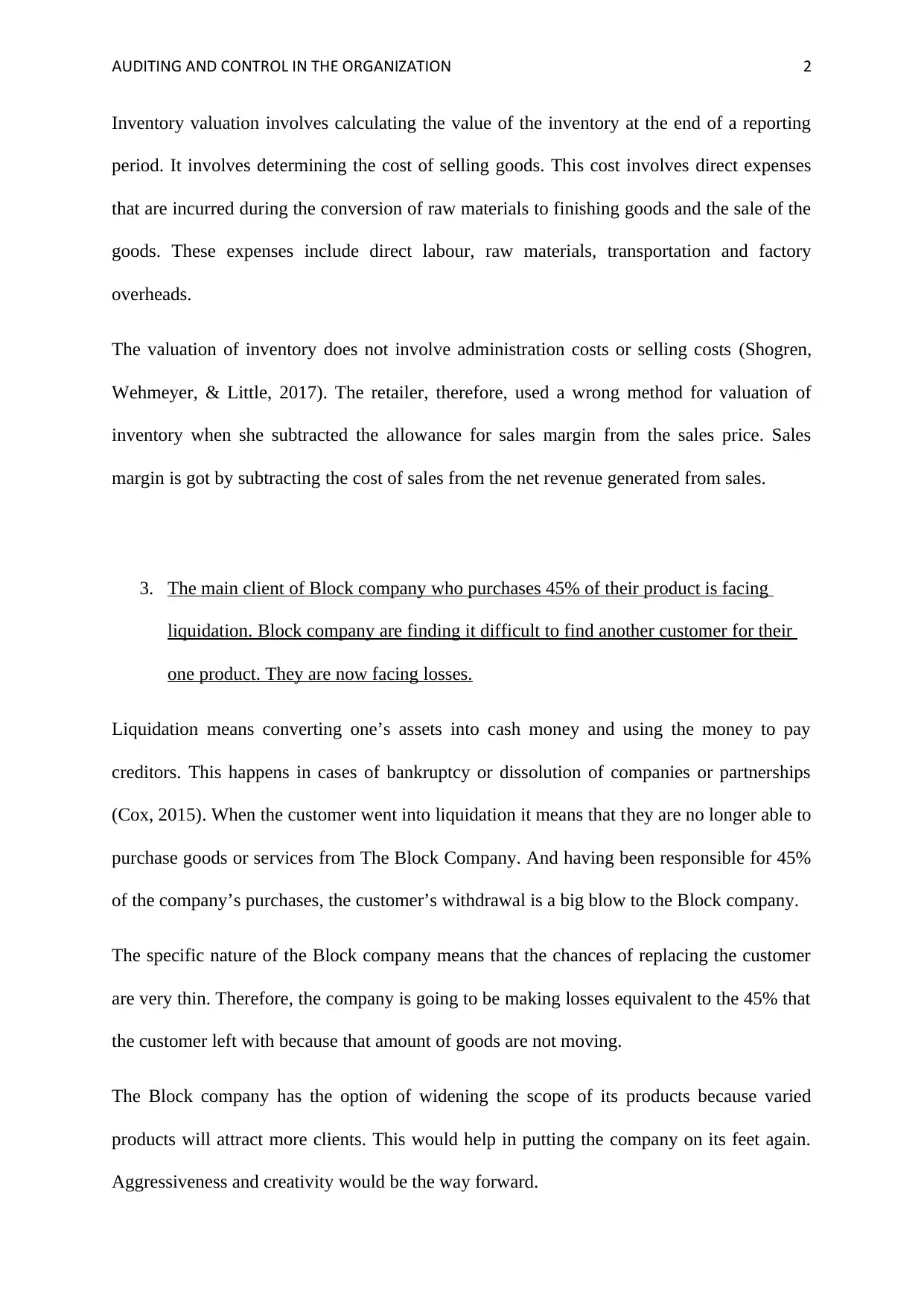
AUDITING AND CONTROL IN THE ORGANIZATION 2
Inventory valuation involves calculating the value of the inventory at the end of a reporting
period. It involves determining the cost of selling goods. This cost involves direct expenses
that are incurred during the conversion of raw materials to finishing goods and the sale of the
goods. These expenses include direct labour, raw materials, transportation and factory
overheads.
The valuation of inventory does not involve administration costs or selling costs (Shogren,
Wehmeyer, & Little, 2017). The retailer, therefore, used a wrong method for valuation of
inventory when she subtracted the allowance for sales margin from the sales price. Sales
margin is got by subtracting the cost of sales from the net revenue generated from sales.
3. The main client of Block company who purchases 45% of their product is facing
liquidation. Block company are finding it difficult to find another customer for their
one product. They are now facing losses.
Liquidation means converting one’s assets into cash money and using the money to pay
creditors. This happens in cases of bankruptcy or dissolution of companies or partnerships
(Cox, 2015). When the customer went into liquidation it means that they are no longer able to
purchase goods or services from The Block Company. And having been responsible for 45%
of the company’s purchases, the customer’s withdrawal is a big blow to the Block company.
The specific nature of the Block company means that the chances of replacing the customer
are very thin. Therefore, the company is going to be making losses equivalent to the 45% that
the customer left with because that amount of goods are not moving.
The Block company has the option of widening the scope of its products because varied
products will attract more clients. This would help in putting the company on its feet again.
Aggressiveness and creativity would be the way forward.
Inventory valuation involves calculating the value of the inventory at the end of a reporting
period. It involves determining the cost of selling goods. This cost involves direct expenses
that are incurred during the conversion of raw materials to finishing goods and the sale of the
goods. These expenses include direct labour, raw materials, transportation and factory
overheads.
The valuation of inventory does not involve administration costs or selling costs (Shogren,
Wehmeyer, & Little, 2017). The retailer, therefore, used a wrong method for valuation of
inventory when she subtracted the allowance for sales margin from the sales price. Sales
margin is got by subtracting the cost of sales from the net revenue generated from sales.
3. The main client of Block company who purchases 45% of their product is facing
liquidation. Block company are finding it difficult to find another customer for their
one product. They are now facing losses.
Liquidation means converting one’s assets into cash money and using the money to pay
creditors. This happens in cases of bankruptcy or dissolution of companies or partnerships
(Cox, 2015). When the customer went into liquidation it means that they are no longer able to
purchase goods or services from The Block Company. And having been responsible for 45%
of the company’s purchases, the customer’s withdrawal is a big blow to the Block company.
The specific nature of the Block company means that the chances of replacing the customer
are very thin. Therefore, the company is going to be making losses equivalent to the 45% that
the customer left with because that amount of goods are not moving.
The Block company has the option of widening the scope of its products because varied
products will attract more clients. This would help in putting the company on its feet again.
Aggressiveness and creativity would be the way forward.
⊘ This is a preview!⊘
Do you want full access?
Subscribe today to unlock all pages.

Trusted by 1+ million students worldwide
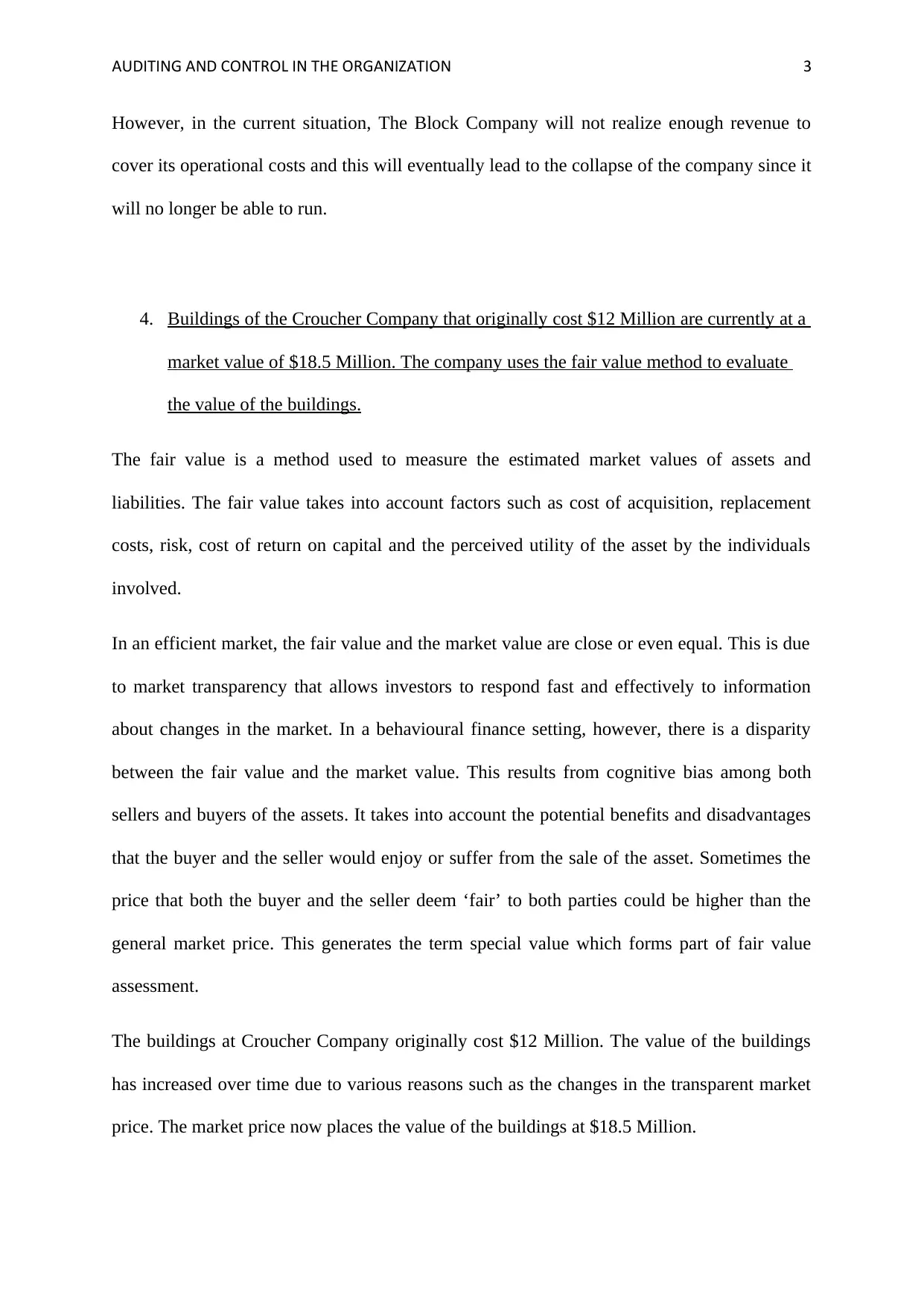
AUDITING AND CONTROL IN THE ORGANIZATION 3
However, in the current situation, The Block Company will not realize enough revenue to
cover its operational costs and this will eventually lead to the collapse of the company since it
will no longer be able to run.
4. Buildings of the Croucher Company that originally cost $12 Million are currently at a
market value of $18.5 Million. The company uses the fair value method to evaluate
the value of the buildings.
The fair value is a method used to measure the estimated market values of assets and
liabilities. The fair value takes into account factors such as cost of acquisition, replacement
costs, risk, cost of return on capital and the perceived utility of the asset by the individuals
involved.
In an efficient market, the fair value and the market value are close or even equal. This is due
to market transparency that allows investors to respond fast and effectively to information
about changes in the market. In a behavioural finance setting, however, there is a disparity
between the fair value and the market value. This results from cognitive bias among both
sellers and buyers of the assets. It takes into account the potential benefits and disadvantages
that the buyer and the seller would enjoy or suffer from the sale of the asset. Sometimes the
price that both the buyer and the seller deem ‘fair’ to both parties could be higher than the
general market price. This generates the term special value which forms part of fair value
assessment.
The buildings at Croucher Company originally cost $12 Million. The value of the buildings
has increased over time due to various reasons such as the changes in the transparent market
price. The market price now places the value of the buildings at $18.5 Million.
However, in the current situation, The Block Company will not realize enough revenue to
cover its operational costs and this will eventually lead to the collapse of the company since it
will no longer be able to run.
4. Buildings of the Croucher Company that originally cost $12 Million are currently at a
market value of $18.5 Million. The company uses the fair value method to evaluate
the value of the buildings.
The fair value is a method used to measure the estimated market values of assets and
liabilities. The fair value takes into account factors such as cost of acquisition, replacement
costs, risk, cost of return on capital and the perceived utility of the asset by the individuals
involved.
In an efficient market, the fair value and the market value are close or even equal. This is due
to market transparency that allows investors to respond fast and effectively to information
about changes in the market. In a behavioural finance setting, however, there is a disparity
between the fair value and the market value. This results from cognitive bias among both
sellers and buyers of the assets. It takes into account the potential benefits and disadvantages
that the buyer and the seller would enjoy or suffer from the sale of the asset. Sometimes the
price that both the buyer and the seller deem ‘fair’ to both parties could be higher than the
general market price. This generates the term special value which forms part of fair value
assessment.
The buildings at Croucher Company originally cost $12 Million. The value of the buildings
has increased over time due to various reasons such as the changes in the transparent market
price. The market price now places the value of the buildings at $18.5 Million.
Paraphrase This Document
Need a fresh take? Get an instant paraphrase of this document with our AI Paraphraser
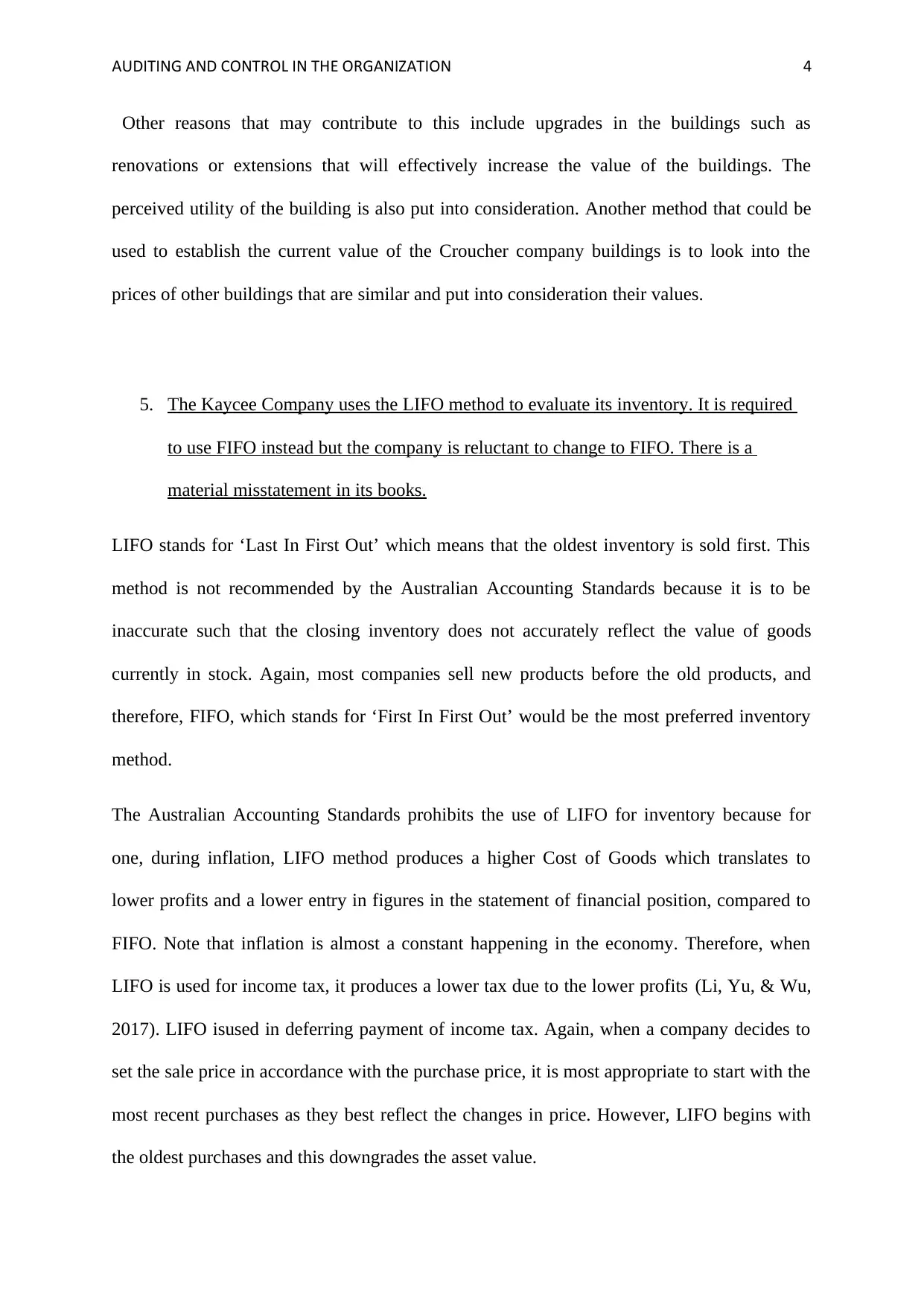
AUDITING AND CONTROL IN THE ORGANIZATION 4
Other reasons that may contribute to this include upgrades in the buildings such as
renovations or extensions that will effectively increase the value of the buildings. The
perceived utility of the building is also put into consideration. Another method that could be
used to establish the current value of the Croucher company buildings is to look into the
prices of other buildings that are similar and put into consideration their values.
5. The Kaycee Company uses the LIFO method to evaluate its inventory. It is required
to use FIFO instead but the company is reluctant to change to FIFO. There is a
material misstatement in its books.
LIFO stands for ‘Last In First Out’ which means that the oldest inventory is sold first. This
method is not recommended by the Australian Accounting Standards because it is to be
inaccurate such that the closing inventory does not accurately reflect the value of goods
currently in stock. Again, most companies sell new products before the old products, and
therefore, FIFO, which stands for ‘First In First Out’ would be the most preferred inventory
method.
The Australian Accounting Standards prohibits the use of LIFO for inventory because for
one, during inflation, LIFO method produces a higher Cost of Goods which translates to
lower profits and a lower entry in figures in the statement of financial position, compared to
FIFO. Note that inflation is almost a constant happening in the economy. Therefore, when
LIFO is used for income tax, it produces a lower tax due to the lower profits (Li, Yu, & Wu,
2017). LIFO isused in deferring payment of income tax. Again, when a company decides to
set the sale price in accordance with the purchase price, it is most appropriate to start with the
most recent purchases as they best reflect the changes in price. However, LIFO begins with
the oldest purchases and this downgrades the asset value.
Other reasons that may contribute to this include upgrades in the buildings such as
renovations or extensions that will effectively increase the value of the buildings. The
perceived utility of the building is also put into consideration. Another method that could be
used to establish the current value of the Croucher company buildings is to look into the
prices of other buildings that are similar and put into consideration their values.
5. The Kaycee Company uses the LIFO method to evaluate its inventory. It is required
to use FIFO instead but the company is reluctant to change to FIFO. There is a
material misstatement in its books.
LIFO stands for ‘Last In First Out’ which means that the oldest inventory is sold first. This
method is not recommended by the Australian Accounting Standards because it is to be
inaccurate such that the closing inventory does not accurately reflect the value of goods
currently in stock. Again, most companies sell new products before the old products, and
therefore, FIFO, which stands for ‘First In First Out’ would be the most preferred inventory
method.
The Australian Accounting Standards prohibits the use of LIFO for inventory because for
one, during inflation, LIFO method produces a higher Cost of Goods which translates to
lower profits and a lower entry in figures in the statement of financial position, compared to
FIFO. Note that inflation is almost a constant happening in the economy. Therefore, when
LIFO is used for income tax, it produces a lower tax due to the lower profits (Li, Yu, & Wu,
2017). LIFO isused in deferring payment of income tax. Again, when a company decides to
set the sale price in accordance with the purchase price, it is most appropriate to start with the
most recent purchases as they best reflect the changes in price. However, LIFO begins with
the oldest purchases and this downgrades the asset value.
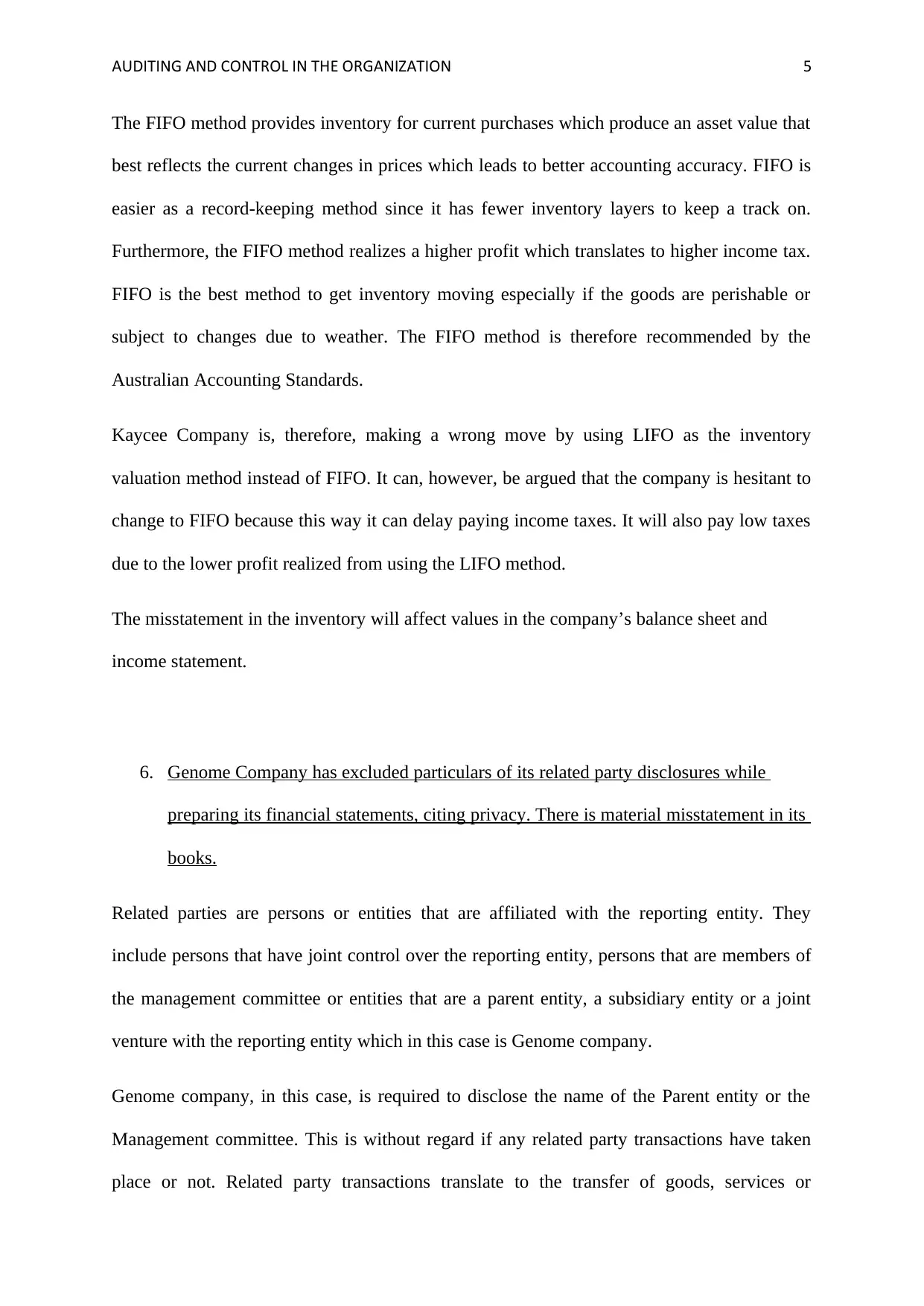
AUDITING AND CONTROL IN THE ORGANIZATION 5
The FIFO method provides inventory for current purchases which produce an asset value that
best reflects the current changes in prices which leads to better accounting accuracy. FIFO is
easier as a record-keeping method since it has fewer inventory layers to keep a track on.
Furthermore, the FIFO method realizes a higher profit which translates to higher income tax.
FIFO is the best method to get inventory moving especially if the goods are perishable or
subject to changes due to weather. The FIFO method is therefore recommended by the
Australian Accounting Standards.
Kaycee Company is, therefore, making a wrong move by using LIFO as the inventory
valuation method instead of FIFO. It can, however, be argued that the company is hesitant to
change to FIFO because this way it can delay paying income taxes. It will also pay low taxes
due to the lower profit realized from using the LIFO method.
The misstatement in the inventory will affect values in the company’s balance sheet and
income statement.
6. Genome Company has excluded particulars of its related party disclosures while
preparing its financial statements, citing privacy. There is material misstatement in its
books.
Related parties are persons or entities that are affiliated with the reporting entity. They
include persons that have joint control over the reporting entity, persons that are members of
the management committee or entities that are a parent entity, a subsidiary entity or a joint
venture with the reporting entity which in this case is Genome company.
Genome company, in this case, is required to disclose the name of the Parent entity or the
Management committee. This is without regard if any related party transactions have taken
place or not. Related party transactions translate to the transfer of goods, services or
The FIFO method provides inventory for current purchases which produce an asset value that
best reflects the current changes in prices which leads to better accounting accuracy. FIFO is
easier as a record-keeping method since it has fewer inventory layers to keep a track on.
Furthermore, the FIFO method realizes a higher profit which translates to higher income tax.
FIFO is the best method to get inventory moving especially if the goods are perishable or
subject to changes due to weather. The FIFO method is therefore recommended by the
Australian Accounting Standards.
Kaycee Company is, therefore, making a wrong move by using LIFO as the inventory
valuation method instead of FIFO. It can, however, be argued that the company is hesitant to
change to FIFO because this way it can delay paying income taxes. It will also pay low taxes
due to the lower profit realized from using the LIFO method.
The misstatement in the inventory will affect values in the company’s balance sheet and
income statement.
6. Genome Company has excluded particulars of its related party disclosures while
preparing its financial statements, citing privacy. There is material misstatement in its
books.
Related parties are persons or entities that are affiliated with the reporting entity. They
include persons that have joint control over the reporting entity, persons that are members of
the management committee or entities that are a parent entity, a subsidiary entity or a joint
venture with the reporting entity which in this case is Genome company.
Genome company, in this case, is required to disclose the name of the Parent entity or the
Management committee. This is without regard if any related party transactions have taken
place or not. Related party transactions translate to the transfer of goods, services or
⊘ This is a preview!⊘
Do you want full access?
Subscribe today to unlock all pages.

Trusted by 1+ million students worldwide
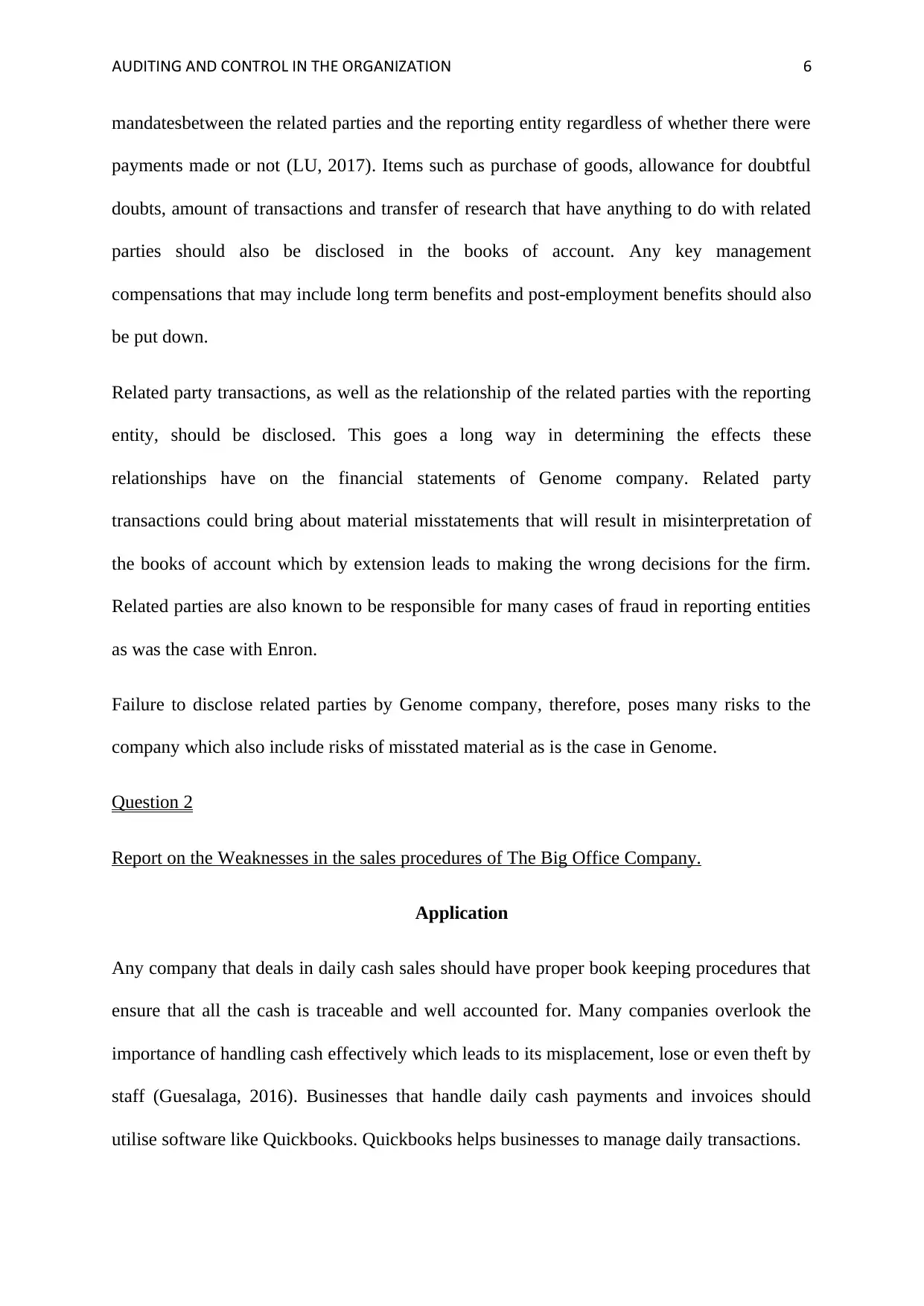
AUDITING AND CONTROL IN THE ORGANIZATION 6
mandatesbetween the related parties and the reporting entity regardless of whether there were
payments made or not (LU, 2017). Items such as purchase of goods, allowance for doubtful
doubts, amount of transactions and transfer of research that have anything to do with related
parties should also be disclosed in the books of account. Any key management
compensations that may include long term benefits and post-employment benefits should also
be put down.
Related party transactions, as well as the relationship of the related parties with the reporting
entity, should be disclosed. This goes a long way in determining the effects these
relationships have on the financial statements of Genome company. Related party
transactions could bring about material misstatements that will result in misinterpretation of
the books of account which by extension leads to making the wrong decisions for the firm.
Related parties are also known to be responsible for many cases of fraud in reporting entities
as was the case with Enron.
Failure to disclose related parties by Genome company, therefore, poses many risks to the
company which also include risks of misstated material as is the case in Genome.
Question 2
Report on the Weaknesses in the sales procedures of The Big Office Company.
Application
Any company that deals in daily cash sales should have proper book keeping procedures that
ensure that all the cash is traceable and well accounted for. Many companies overlook the
importance of handling cash effectively which leads to its misplacement, lose or even theft by
staff (Guesalaga, 2016). Businesses that handle daily cash payments and invoices should
utilise software like Quickbooks. Quickbooks helps businesses to manage daily transactions.
mandatesbetween the related parties and the reporting entity regardless of whether there were
payments made or not (LU, 2017). Items such as purchase of goods, allowance for doubtful
doubts, amount of transactions and transfer of research that have anything to do with related
parties should also be disclosed in the books of account. Any key management
compensations that may include long term benefits and post-employment benefits should also
be put down.
Related party transactions, as well as the relationship of the related parties with the reporting
entity, should be disclosed. This goes a long way in determining the effects these
relationships have on the financial statements of Genome company. Related party
transactions could bring about material misstatements that will result in misinterpretation of
the books of account which by extension leads to making the wrong decisions for the firm.
Related parties are also known to be responsible for many cases of fraud in reporting entities
as was the case with Enron.
Failure to disclose related parties by Genome company, therefore, poses many risks to the
company which also include risks of misstated material as is the case in Genome.
Question 2
Report on the Weaknesses in the sales procedures of The Big Office Company.
Application
Any company that deals in daily cash sales should have proper book keeping procedures that
ensure that all the cash is traceable and well accounted for. Many companies overlook the
importance of handling cash effectively which leads to its misplacement, lose or even theft by
staff (Guesalaga, 2016). Businesses that handle daily cash payments and invoices should
utilise software like Quickbooks. Quickbooks helps businesses to manage daily transactions.
Paraphrase This Document
Need a fresh take? Get an instant paraphrase of this document with our AI Paraphraser
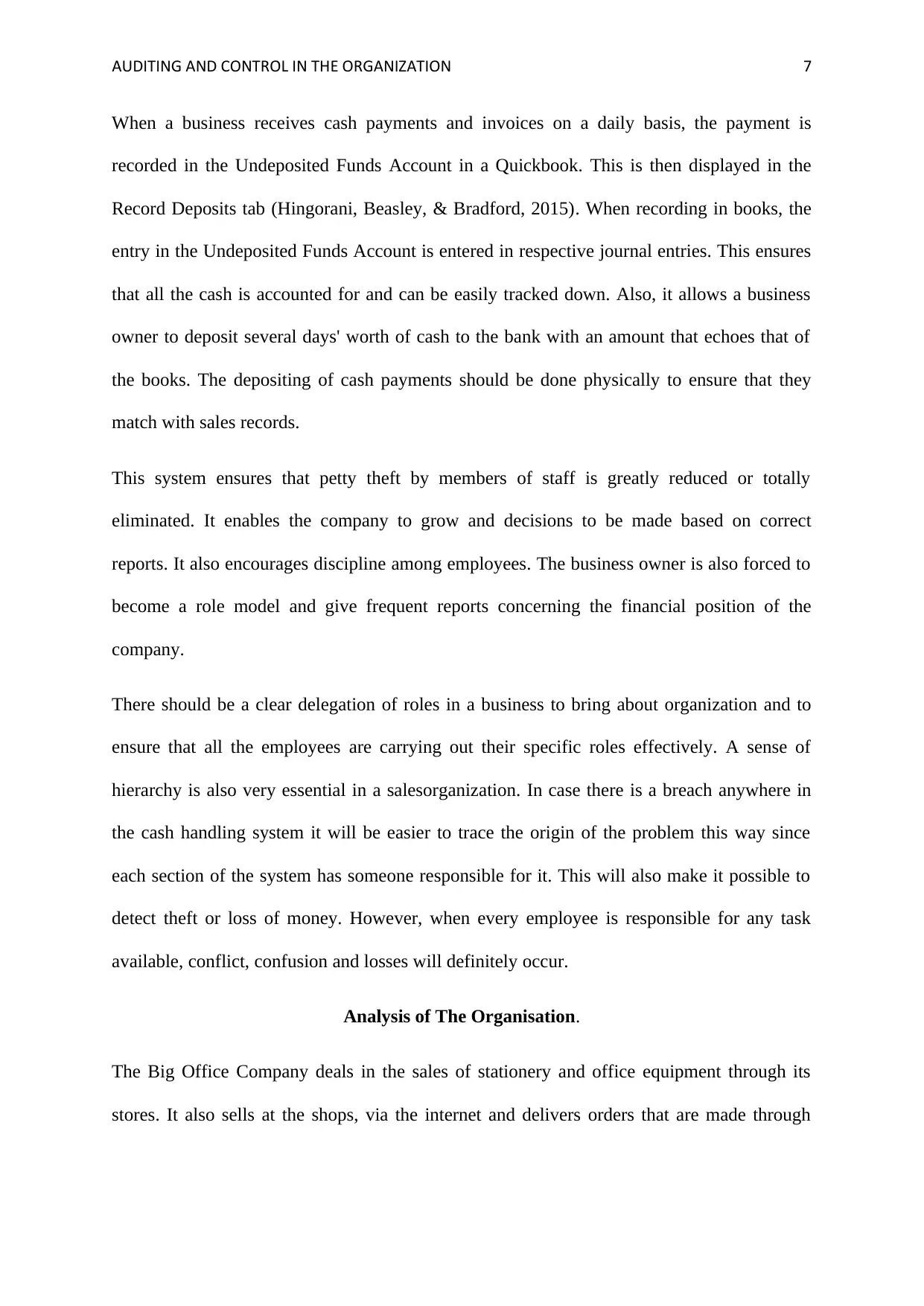
AUDITING AND CONTROL IN THE ORGANIZATION 7
When a business receives cash payments and invoices on a daily basis, the payment is
recorded in the Undeposited Funds Account in a Quickbook. This is then displayed in the
Record Deposits tab (Hingorani, Beasley, & Bradford, 2015). When recording in books, the
entry in the Undeposited Funds Account is entered in respective journal entries. This ensures
that all the cash is accounted for and can be easily tracked down. Also, it allows a business
owner to deposit several days' worth of cash to the bank with an amount that echoes that of
the books. The depositing of cash payments should be done physically to ensure that they
match with sales records.
This system ensures that petty theft by members of staff is greatly reduced or totally
eliminated. It enables the company to grow and decisions to be made based on correct
reports. It also encourages discipline among employees. The business owner is also forced to
become a role model and give frequent reports concerning the financial position of the
company.
There should be a clear delegation of roles in a business to bring about organization and to
ensure that all the employees are carrying out their specific roles effectively. A sense of
hierarchy is also very essential in a salesorganization. In case there is a breach anywhere in
the cash handling system it will be easier to trace the origin of the problem this way since
each section of the system has someone responsible for it. This will also make it possible to
detect theft or loss of money. However, when every employee is responsible for any task
available, conflict, confusion and losses will definitely occur.
Analysis of The Organisation.
The Big Office Company deals in the sales of stationery and office equipment through its
stores. It also sells at the shops, via the internet and delivers orders that are made through
When a business receives cash payments and invoices on a daily basis, the payment is
recorded in the Undeposited Funds Account in a Quickbook. This is then displayed in the
Record Deposits tab (Hingorani, Beasley, & Bradford, 2015). When recording in books, the
entry in the Undeposited Funds Account is entered in respective journal entries. This ensures
that all the cash is accounted for and can be easily tracked down. Also, it allows a business
owner to deposit several days' worth of cash to the bank with an amount that echoes that of
the books. The depositing of cash payments should be done physically to ensure that they
match with sales records.
This system ensures that petty theft by members of staff is greatly reduced or totally
eliminated. It enables the company to grow and decisions to be made based on correct
reports. It also encourages discipline among employees. The business owner is also forced to
become a role model and give frequent reports concerning the financial position of the
company.
There should be a clear delegation of roles in a business to bring about organization and to
ensure that all the employees are carrying out their specific roles effectively. A sense of
hierarchy is also very essential in a salesorganization. In case there is a breach anywhere in
the cash handling system it will be easier to trace the origin of the problem this way since
each section of the system has someone responsible for it. This will also make it possible to
detect theft or loss of money. However, when every employee is responsible for any task
available, conflict, confusion and losses will definitely occur.
Analysis of The Organisation.
The Big Office Company deals in the sales of stationery and office equipment through its
stores. It also sells at the shops, via the internet and delivers orders that are made through
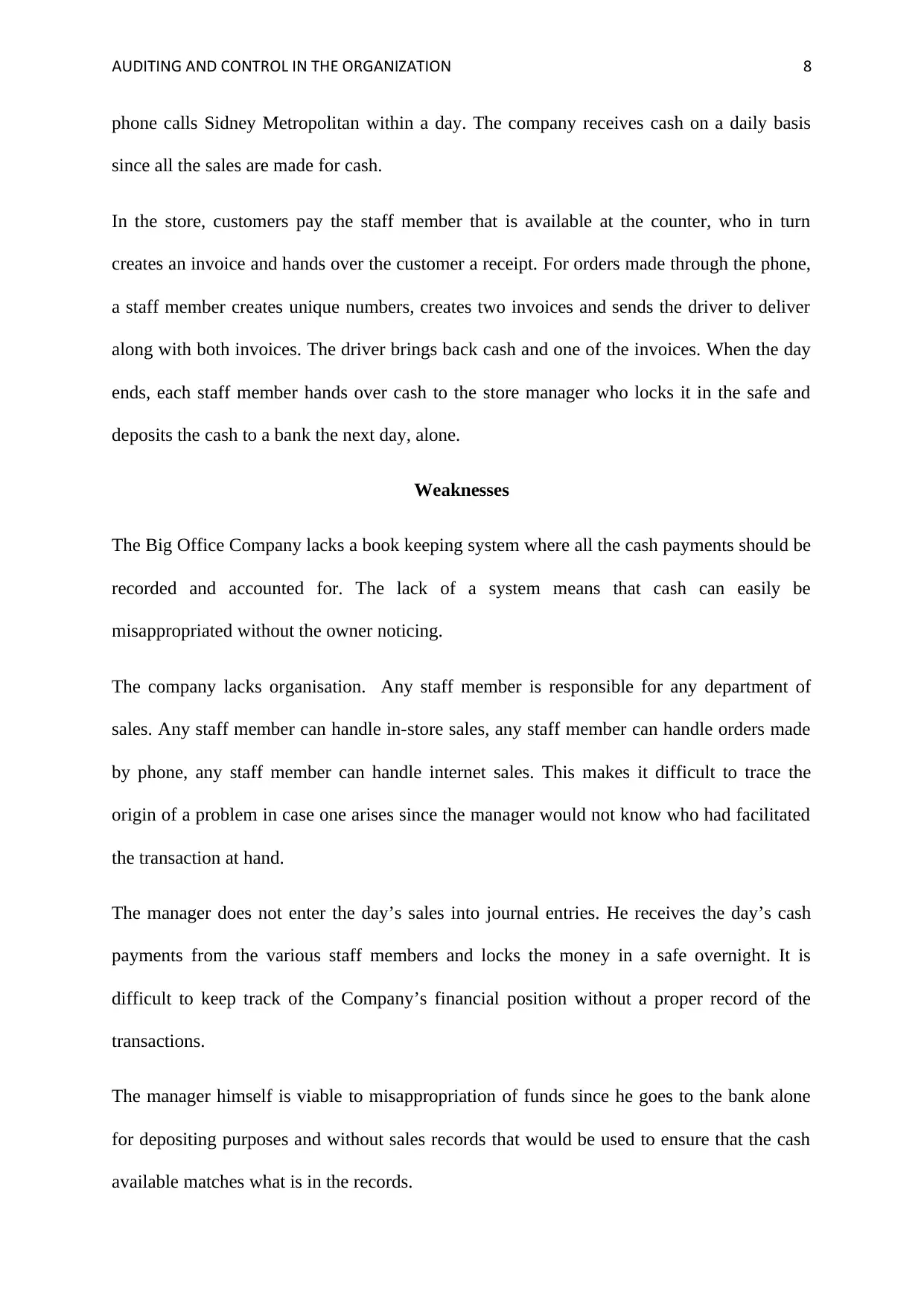
AUDITING AND CONTROL IN THE ORGANIZATION 8
phone calls Sidney Metropolitan within a day. The company receives cash on a daily basis
since all the sales are made for cash.
In the store, customers pay the staff member that is available at the counter, who in turn
creates an invoice and hands over the customer a receipt. For orders made through the phone,
a staff member creates unique numbers, creates two invoices and sends the driver to deliver
along with both invoices. The driver brings back cash and one of the invoices. When the day
ends, each staff member hands over cash to the store manager who locks it in the safe and
deposits the cash to a bank the next day, alone.
Weaknesses
The Big Office Company lacks a book keeping system where all the cash payments should be
recorded and accounted for. The lack of a system means that cash can easily be
misappropriated without the owner noticing.
The company lacks organisation. Any staff member is responsible for any department of
sales. Any staff member can handle in-store sales, any staff member can handle orders made
by phone, any staff member can handle internet sales. This makes it difficult to trace the
origin of a problem in case one arises since the manager would not know who had facilitated
the transaction at hand.
The manager does not enter the day’s sales into journal entries. He receives the day’s cash
payments from the various staff members and locks the money in a safe overnight. It is
difficult to keep track of the Company’s financial position without a proper record of the
transactions.
The manager himself is viable to misappropriation of funds since he goes to the bank alone
for depositing purposes and without sales records that would be used to ensure that the cash
available matches what is in the records.
phone calls Sidney Metropolitan within a day. The company receives cash on a daily basis
since all the sales are made for cash.
In the store, customers pay the staff member that is available at the counter, who in turn
creates an invoice and hands over the customer a receipt. For orders made through the phone,
a staff member creates unique numbers, creates two invoices and sends the driver to deliver
along with both invoices. The driver brings back cash and one of the invoices. When the day
ends, each staff member hands over cash to the store manager who locks it in the safe and
deposits the cash to a bank the next day, alone.
Weaknesses
The Big Office Company lacks a book keeping system where all the cash payments should be
recorded and accounted for. The lack of a system means that cash can easily be
misappropriated without the owner noticing.
The company lacks organisation. Any staff member is responsible for any department of
sales. Any staff member can handle in-store sales, any staff member can handle orders made
by phone, any staff member can handle internet sales. This makes it difficult to trace the
origin of a problem in case one arises since the manager would not know who had facilitated
the transaction at hand.
The manager does not enter the day’s sales into journal entries. He receives the day’s cash
payments from the various staff members and locks the money in a safe overnight. It is
difficult to keep track of the Company’s financial position without a proper record of the
transactions.
The manager himself is viable to misappropriation of funds since he goes to the bank alone
for depositing purposes and without sales records that would be used to ensure that the cash
available matches what is in the records.
⊘ This is a preview!⊘
Do you want full access?
Subscribe today to unlock all pages.

Trusted by 1+ million students worldwide
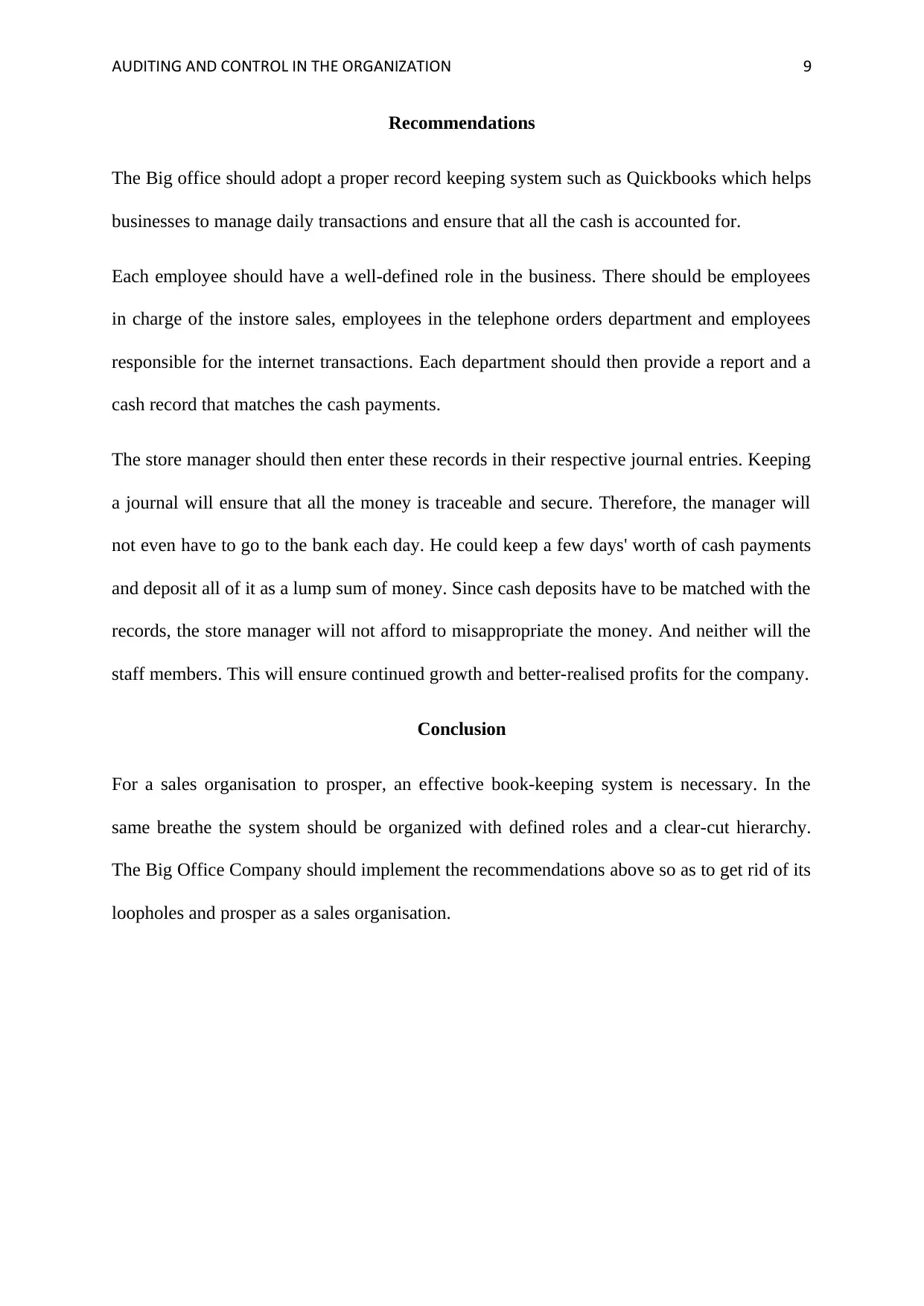
AUDITING AND CONTROL IN THE ORGANIZATION 9
Recommendations
The Big office should adopt a proper record keeping system such as Quickbooks which helps
businesses to manage daily transactions and ensure that all the cash is accounted for.
Each employee should have a well-defined role in the business. There should be employees
in charge of the instore sales, employees in the telephone orders department and employees
responsible for the internet transactions. Each department should then provide a report and a
cash record that matches the cash payments.
The store manager should then enter these records in their respective journal entries. Keeping
a journal will ensure that all the money is traceable and secure. Therefore, the manager will
not even have to go to the bank each day. He could keep a few days' worth of cash payments
and deposit all of it as a lump sum of money. Since cash deposits have to be matched with the
records, the store manager will not afford to misappropriate the money. And neither will the
staff members. This will ensure continued growth and better-realised profits for the company.
Conclusion
For a sales organisation to prosper, an effective book-keeping system is necessary. In the
same breathe the system should be organized with defined roles and a clear-cut hierarchy.
The Big Office Company should implement the recommendations above so as to get rid of its
loopholes and prosper as a sales organisation.
Recommendations
The Big office should adopt a proper record keeping system such as Quickbooks which helps
businesses to manage daily transactions and ensure that all the cash is accounted for.
Each employee should have a well-defined role in the business. There should be employees
in charge of the instore sales, employees in the telephone orders department and employees
responsible for the internet transactions. Each department should then provide a report and a
cash record that matches the cash payments.
The store manager should then enter these records in their respective journal entries. Keeping
a journal will ensure that all the money is traceable and secure. Therefore, the manager will
not even have to go to the bank each day. He could keep a few days' worth of cash payments
and deposit all of it as a lump sum of money. Since cash deposits have to be matched with the
records, the store manager will not afford to misappropriate the money. And neither will the
staff members. This will ensure continued growth and better-realised profits for the company.
Conclusion
For a sales organisation to prosper, an effective book-keeping system is necessary. In the
same breathe the system should be organized with defined roles and a clear-cut hierarchy.
The Big Office Company should implement the recommendations above so as to get rid of its
loopholes and prosper as a sales organisation.
Paraphrase This Document
Need a fresh take? Get an instant paraphrase of this document with our AI Paraphraser
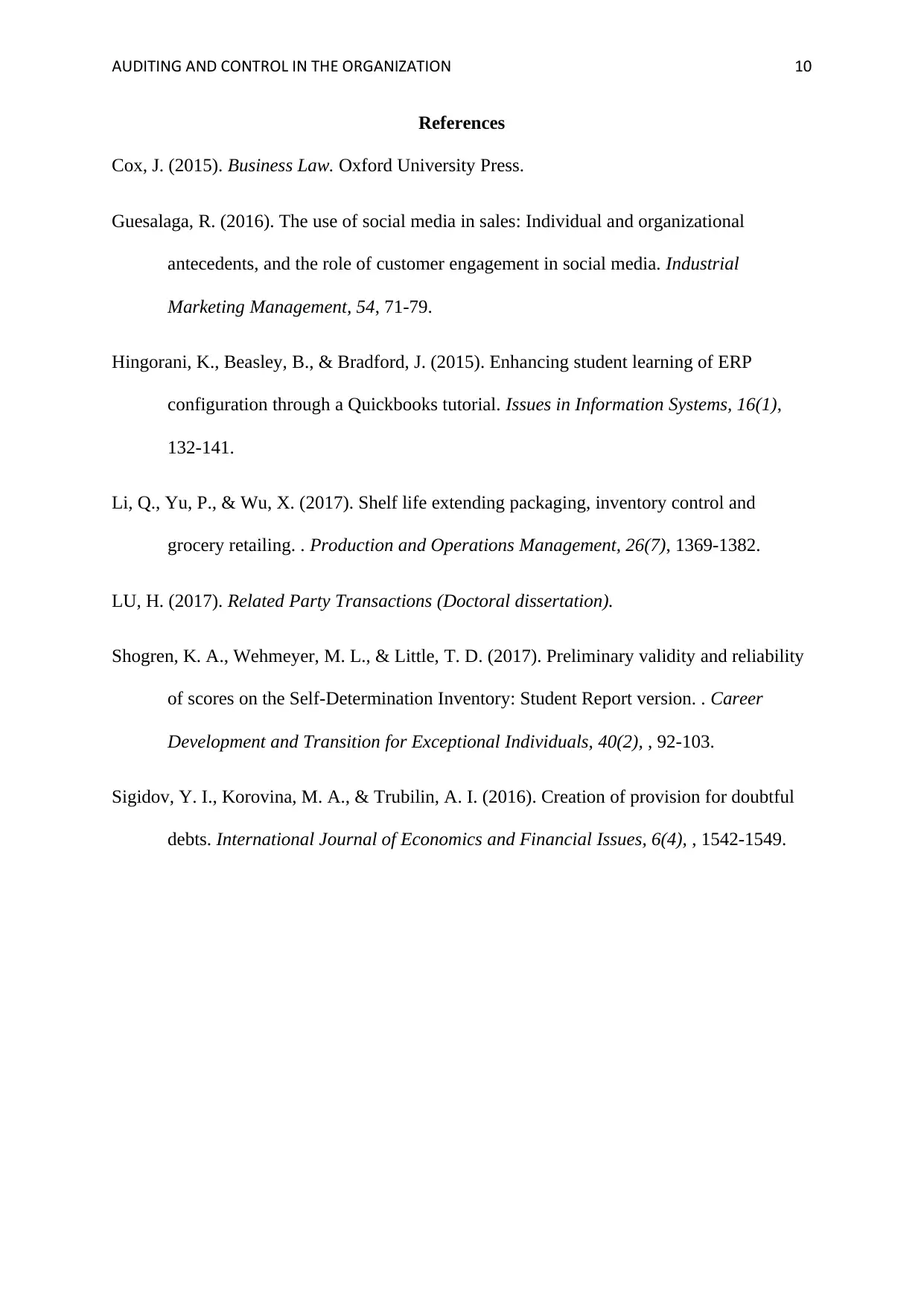
AUDITING AND CONTROL IN THE ORGANIZATION 10
References
Cox, J. (2015). Business Law. Oxford University Press.
Guesalaga, R. (2016). The use of social media in sales: Individual and organizational
antecedents, and the role of customer engagement in social media. Industrial
Marketing Management, 54, 71-79.
Hingorani, K., Beasley, B., & Bradford, J. (2015). Enhancing student learning of ERP
configuration through a Quickbooks tutorial. Issues in Information Systems, 16(1),
132-141.
Li, Q., Yu, P., & Wu, X. (2017). Shelf life extending packaging, inventory control and
grocery retailing. . Production and Operations Management, 26(7), 1369-1382.
LU, H. (2017). Related Party Transactions (Doctoral dissertation).
Shogren, K. A., Wehmeyer, M. L., & Little, T. D. (2017). Preliminary validity and reliability
of scores on the Self-Determination Inventory: Student Report version. . Career
Development and Transition for Exceptional Individuals, 40(2), , 92-103.
Sigidov, Y. I., Korovina, M. A., & Trubilin, A. I. (2016). Creation of provision for doubtful
debts. International Journal of Economics and Financial Issues, 6(4), , 1542-1549.
References
Cox, J. (2015). Business Law. Oxford University Press.
Guesalaga, R. (2016). The use of social media in sales: Individual and organizational
antecedents, and the role of customer engagement in social media. Industrial
Marketing Management, 54, 71-79.
Hingorani, K., Beasley, B., & Bradford, J. (2015). Enhancing student learning of ERP
configuration through a Quickbooks tutorial. Issues in Information Systems, 16(1),
132-141.
Li, Q., Yu, P., & Wu, X. (2017). Shelf life extending packaging, inventory control and
grocery retailing. . Production and Operations Management, 26(7), 1369-1382.
LU, H. (2017). Related Party Transactions (Doctoral dissertation).
Shogren, K. A., Wehmeyer, M. L., & Little, T. D. (2017). Preliminary validity and reliability
of scores on the Self-Determination Inventory: Student Report version. . Career
Development and Transition for Exceptional Individuals, 40(2), , 92-103.
Sigidov, Y. I., Korovina, M. A., & Trubilin, A. I. (2016). Creation of provision for doubtful
debts. International Journal of Economics and Financial Issues, 6(4), , 1542-1549.
1 out of 11
Related Documents
Your All-in-One AI-Powered Toolkit for Academic Success.
+13062052269
info@desklib.com
Available 24*7 on WhatsApp / Email
![[object Object]](/_next/static/media/star-bottom.7253800d.svg)
Unlock your academic potential
Copyright © 2020–2025 A2Z Services. All Rights Reserved. Developed and managed by ZUCOL.





